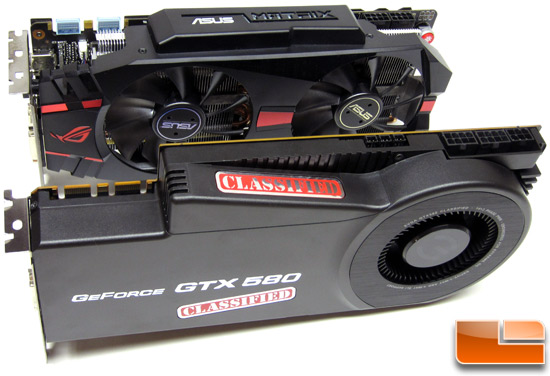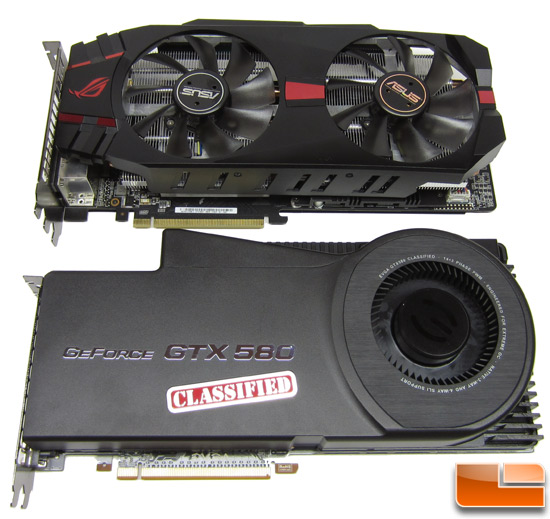GeForce GTX 580 Showdown: ASUS Matrix vs.EVGA Classified
The NVIDIA GeForce GTX580 Showdown
Not too many people have over $500 to spend on a video card, but for those fortunate to be able to there are there are a fair number of options to pick from. When it comes to spending that much money on a video card there are two companies you’ll want to take a closer look at: ASUS and EVGA. These two companies have been developing high-end enthusiast graphics cards for years that usually feature custom designs that will blow your mind. When you are spending over $500 on a single graphics card you usually want more than the AMD or NVIDIA reference design! The NVIDIA GeForce GTX 580 is the flagship single-GPU solution from NVIDIA and it is pretty darn fast in standard form. The engineers at ASUS and EVGA took that GPU and came up with two totally custom designs that they felt were better solutions for gamers and enthusiasts.

The cards sent to Legit Reviews for review were the ASUS MATRIX GTX580 1536MB (P/2DIS/1536MD5) and EVGA GeForce GTX 580 Classified 3072MB (3G-P3-1588-AR). These cards represent the fastest air cooled NVIDIA GeForce GTX580 video card from each respective company. The ASUS MATRIX GTX580 comes with clock frequencies of 816MHz core and 4008MHz memory for $529.99 plus shipping. The EVGA GeForce GTX 580 Classified comes with clock frequencies of 855Mhz core and 4212MHz memory for $599.99 plus shipping. The question that we hope to answer for you today is which of these two cards is the best.

Let’s take a look at the features of these cards compared to the NVIDIA GeForce GTX 580 reference design.
| Graphics card | GeForce GTX 580 | ASUS MATRIX GTX580 Platinum | EVGA GTX 580 Classified |
| Fabrication node | 40nm | 40nm | 40nm |
| Shader processors | 512 | 512 | 512 |
| Streaming Multiprocessors | 16 | 16 | 16 |
| Texture Units | 60 | 64 | 64 |
| ROP units | 48 | 48 | 48 |
| Graphics Clock (Core) | 772 MHz | 816 MHz | 855 MHz |
| Shader Processor Clock | 1544 MHz | 1632 MHz | 1710 MHz |
| Memory Clock / Data rate | 1002 MHz / 4008 MHz | 1002 MHz / 4008 MHz | 1053 MHZ / 4212 MHz |
| Graphics memory | 1536 MB | 1536 MB | 3072 MB |
| Memory interface | 384-bit | 384-bit | 384-bit |
| Memory bandwidth | 192.4 GB/s | 192.4 GB/s | 202 GB/s |
| Power connectors | 1×6-pin PEG, 1×8-pin PEG | 2×8-pin PEG | 1×6-pin PEG, 2×8-pin PEG |
| Max board power (TDP) | 244 Watts | unknown | 260 Watts |
| Recommended Power supply | 600 Watts | 700 Watts | 600 Watts |
| GPU Thermal Threshold | 105 degrees C | 97 degrees C | 97 degrees C |
You might be thinking right now that this review is going to end with us praising both cards, but that isn’t what will be happening. Both EVGA and ASUS were okay with these cards going against each other with a winner being declared at the end. Both graphics cards are without a doubt winners, but today there will be only one.
We will be looking in-depth at each card showing you their features and then will be looking at the following areas to declare a winner:
- Accessory Bundle
- Gaming Performance
- Overclock
- Power Consumption
- Temperatures
- Noise Level
This should be interesting, so let’s get to it!

Comments are closed.